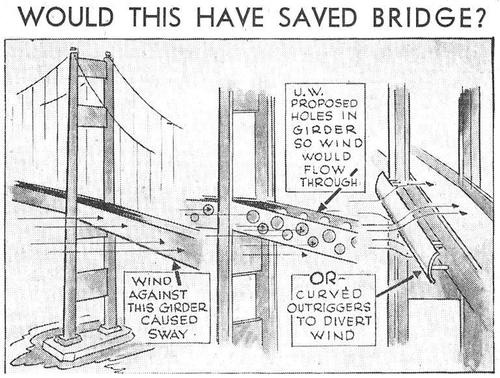Engineering Disasters: Galloping Gertie – the Tacoma Narrows Bridge
November 25, 2014

Here's an engineering disaster that made the engineering history books. The first Tacoma Narrows Bridge was a Washington State suspension bridge that opened in 1940 and spanned the Tacoma Narrows strait of Puget Sound between Tacoma and the Kitsap Peninsula. It opened to traffic on July 1, 1940, and dramatically collapsed into Puget Sound on November 7, just four months after it opened. At the time of its construction -- and its destruction -- the bridge was the third-longest suspension bridge in the world in terms of main span length, just behind the Golden Gate Bridge and the George Washington Bridge.
The collapse of the bridge came as no surprise to the workers who were startled by the wild swings of the bridge during even mild winds. Construction on the bridge began in September 1938. As soon as the deck was built, it began to move vertically in windy conditions. Nervous construction workers gave the bridge the nickname Galloping Gertie. The motion could be seen even when the bridge opened to the public. Engineers took several measures to stop the motion, but they were ineffective. The main span collapsed under 40 mph winds on the morning of November 7, 1940.
Watch the bridge sway and collapse:
Last man on the bridge
Nobody was killed when the bridge finally collapsed. Leonard Coatsworth, editor of the Tacoma News Tribune, was the last person to drive on the bridge. "Just as I drove past the towers, the bridge began to sway violently from side to side. Before I realized it, the tilt became so violent that I lost control of the car," Coatsworth wrote in his paper. "I jammed on the brakes and got out, only to be thrown onto my face against the curb. Around me I could hear concrete cracking. The car itself began to slide from side to side of the roadway."
Coatsworth crawled on his hands and knees 500 yards to reach the towers and safety. "My breath was coming in gasps. My knees were raw and bleeding, and my hands bruised and swollen from gripping the concrete curb." As he approached safety, he rose to his feet and ran the last few yards to the toll plaza. "I saw the bridge in its final collapse and saw my car plunge into the Narrows."

The fatal decision behind the failure
The decision to use shallow and narrow girders was the choice that brought the bridge down. With minimal girders, the deck of the bridge was insufficiently rigid and was easily moved by wind. A mild-to-moderate wind caused alternate halves of the center span to visibly rise and fall several feet during four- to five-second intervals.
The bridge's collapse had a lasting effect on science and engineering. In many physics textbooks, the bridge collapse is used as an example of elementary forced resonance with the wind providing an external periodic frequency that matched the bridge's natural structural frequency. The actual cause of failure has been attributed to aeroelastic flutter. The bridge failure boosted research in the field of bridge aerodynamics and aeroelastics. These studies have influenced the design of every long-span bridge built since 1940.
About the Author(s)
You May Also Like





